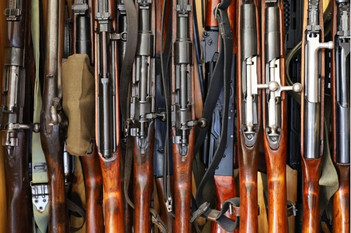8 Things You Should Always Inspect on a Military Surplus Firearm
Aug 22nd 2024
We’ve published at length before about the incredible value you can often find in military surplus firearms. If you do your research right and put in the time shopping, you can often get a great deal.
So let’s fast forward - you’ve put in the time and you think the steal of the century is right there on the counter. What things should you inspect on the gun to make sure you’re not getting swindled?
Well, this guide isn’t comprehensive, but it’s a good place to start.
Note: make sure you get permission from the person showing you the firearm to remove and parts or test any controls.
The Bore
The bore of any military surplus firearm is the first thing you should check. Hard use verging on abuse and little to no field care can leave both smooth and rifled bores in pitifully bad shape.
Worst of all, the bore might be in terrible shape and hiding behind a relatively spotless facade. Do not buy any surplus firearm unless the seller lets you investigate the bore with a bore light.
A little fouling is no big deal and on used guns might even be expected, although it is not desirable. With that said, you should look for pitting, corrosion, and shadows which can indicate bulges or bends in the barrel.
In any of those cases, give the gun back to the seller. It’s not worth buying.
The Muzzle Crowning
For rifled firearms, the muzzle crowning - that is, the last section of rifling at the muzzle, which is the last part of the bore the bullet contacts before leaving the gun - is critical to accuracy.
Guns that have been poorly cared for, used hard, cleaned minimally, or cleaned improperly (from the muzzle end) can have damaged crowning. Inspect it while looking over the gun; if the crowning is pitted, rusted, or deformed, pass.
The Trigger
Granted, this is something you should check in literally any gun before buying, and not just in military surplus firearms, but it is important nonetheless.
One, you want to make sure there is no play in the trigger, that it isn’t mushy, and that it breaks and resets (if applicable) crisply and reliably.
On some guns, replacing a trigger group is no big deal, but it is still something to be cognizant of while you’re looking around.
The Stock
Most issues with a gun’s stock are not only cosmetic, but can be fixed simply by replacing the stock. Be that as it may, the stock may also hide problems that are much more difficult to fix.
For instance, where the barrel is bedded, the stock may conceal problems like rust or dry rot. Small chips and scratches are not cause for concern, but cracks that travel along the grain are, as they will only widen with time.
All in all, if you have a damaged stock and are not confident that you can easily and cost-effectively remove it, pass.
All Manual Controls
Work the action of the gun; this includes action bars or locks, slides, bolts, bolt and slide releases, and for revolvers, cylinder releases. For semi-autos ensure that the action operates freely and that all catches and releases are working.
For magazine-fed platforms, charge and drop the mag a few times to ensure that the catch and release are working.
If the gun has a safety, though it might not, test this (with the shop owner’s permission) to ensure that it is functional.
External Hardware
Though this shouldn’t be a dealbreaker, there is often external hardware missing from used guns and military surplus firearms are no exception.
This includes but is not limited to sights, sling mounts, screws, pins and other hardware, and can include the magazine, too. Give the platform a once over to ensure that everything is where it should be.
On Shotguns: The Choke
If you’re inspecting a shotgun with interchangeable chokes, such as a used 870, inspect to make sure the choke is present. You should also ask for a choke wrench and make sure that the choke is not seized.
Last but Not Least: The Serial Number
While it is true that many military surplus firearms may not have a serial number at all, if there is one, that is something you should inspect. This is because it will enable you to look further into the platform’s production history - but most importantly, it is because some runs are known for their issues.
For instance, some M14 rifles, as well as some low-number M1903 rifles, are known to have issues. If you can, identify the serial number and then do a quick internet search to see if that number presents any cause for concern.
Start Your Search for Military Surplus Firearms Here

Interested in jumping into the world of military surplus firearms, and seeing if you can find the deal of a lifetime? This short post will get you started out right. Make sure you heed these bits of wisdom and do some extra research on the platform in question so you know specifically what to inspect and watch out for - the deal is out there, you just need to find it.

